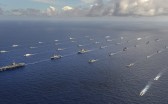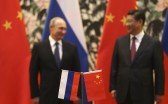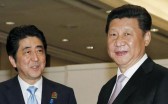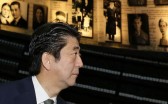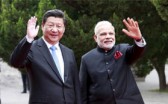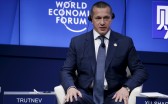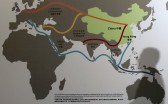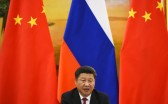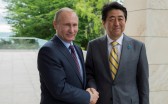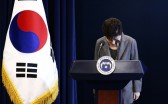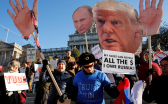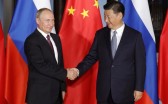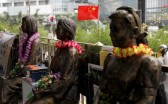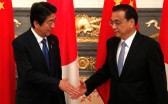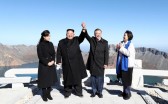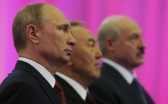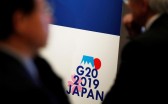Russia until recently anticipated a rapprochement with the United States without damage to its close relations with China. Indeed, given anticipated tensions in US-China relations, the result would be advantageous for Russia: making it the pivot in the “strategic triangle” of these three great powers; sustaining its “pivot to the East” while rebuilding its ties to the West; and realizing long-expressed aspirations for reviving its special international status. While the developments of the recent weeks have left Russia where it was in the past few years, there continue to be expectations that the impasse in its US ties can be overcome. If prospects for improved ties can slip abruptly, one can surmise that they could revive, too. In this potentially positive scenario, stress is put on the potential for US-Russia cooperation in the Asia-Pacific.
US strikes against Syria—perceived in Russia as carried out without any legitimate justification and described by Vladimir Putin as “an aggression against a sovereign government in violation of the norms of international law, and under a far-fetched pretext”—dealt a “significant blow” to US-Russia relations.1 Further, US-Russia contacts aimed at mending the relationship as well as finding common ground on specific issues such as fighting terrorism are likely to become more complicated as the rift over Syria is deepening. However, this does not imply that US-Russia ties cannot be repaired, as both Donald Trump and Putin expressed a desire to overcome the period of severely strained relations under the previous US administration and cooperate on issues of common interest.
Putin has repeatedly stated his willingness to take every step necessary to repair relations with the United States. During the first meeting between Foreign Minister Sergey Lavrov and Secretary of State Rex Tillerson on February 16 in Bonn, they confirmed their mutual interests, especially in fighting terrorism. Tillerson stated that the United States would consider working with Russia when they could find areas of practical cooperation that will benefit the American people.2 Tillerson visited Moscow and met with Lavrov and Putin on April 12. After frank talks, the two sides agreed to establish a working group on the most important issues of bilateral relations in order to restore mutual trust. Trump praised the result of these negotiations and, while stating that the relations now may be at an all-time low, expressed his hope to get along with Russia3.
With the Trump administration’s hardened line vis-à-vis Russia since March, strained relations over Syria and Ukraine, Asia could be the region where possible US-Russia cooperation can be realized. However, the current crisis in US-Russia relations means that almost all working level channels were suspended, and there is virtually no cooperation in Asia. What is more, all Russian regional initiatives—for instance, in regional organizations of the East Asian Summit and APEC—are impeded by the interference of the United States or its like-minded allies such as Australia. This positive scenario develops a case for US-Russia cooperation in Asia as a previously overlooked opportunity, the prospect of which would be beneficial for both states.
Factors behind Possible Russia-US Cooperation in Asia
Russia has mostly been absent from the US strategic thinking towards the Asia-Pacific and is rarely perceived as a significant player in the region. The US-Russia relations mostly focus on other regions such as the Euro-Atlantic, the Middle East, and Central Asia, where competition and frictions prevail. On the contrary, in the Asia-Pacific, overlapping interests are more pronounced than divergences between the countries. This is the case even if we take into account China’s formidable presence in Asia, adding a triangular element to many calculations.
First, both the United States and Russia are Pacific powers, whose future prosperity and security depend to a significant extent on the situation in the Asia-Pacific. The US pivot or rebalance to Asia prioritizes US engagement in this particular region, representing a multifaceted and prolonged approach that reflects its long-term importance of the region.4 While it is too soon to judge how this policy is going to be shaped under the current administration with the shift of foreign policy priorities under the “America First” slogan, the key priorities of the pivot may remain in place.5 Russia’s own Asian pivot or “turn to the East” reflects the ambition to diversify its foreign policy portfolio, deepen relations with East Asian countries, as well as establish itself as a major regional power, with a vision for a polycentric order in this strategically important region. This policy, although not without shortcomings, has been accelerated after the Ukrainian crisis and the rift with the West. One of the major goals of Russia’s Asian pivot has been the development of the regions of Siberia and the Russian Far East (RFE), which has been declared a “national priority for the whole 21st century.”
Hence, both countries wish to be more actively involved in this dynamically developing region and have increasing stakes in Asian security. Taking into consideration the development of the RFE, Russia is a strong proponent of peace and stability in the region, as any conflict will make the RFE project less attractive and weaken Russia’s already uncertain standing in the region. Notwithstanding the divergence between the United States and Russia over how to treat Russia’s actions in Europe, Russia has no revisionist agenda in Asia, and this makes it a reliable partner for US strategic calculations. For Russia’s Asian pivot to succeed, it needs to improve relations with the US in the Asia-Pacific; otherwise it would be significantly impeded.
Second, non-proliferation has been an important priority for both Russia and the United States. Although they differ in their policy options towards the Korean Peninsula, both have been proponents of the nuclear non-proliferation regime. Third, both countries have prioritized engagement in multilateral institutions in the region and improving relations with ASEAN.6
The issue on which the US and Russia’s positions diverge considerably is the regional order and regional security architecture. The United States favors the “hub-and-spokes” system of bilateral alliances and considers it to be an adequate architecture for the region’s current security challenges. From Russia’s official perspective, the US alliance system, a thing of the Cold War, does not fit into the contemporary economic and security environment and is not enough to provide security for the whole region as it is an exclusive system that guarantees the security of the few at the expense of region-wide security.
Hence, Russia calls for a new approach to regional security, a more balanced and inclusive system based on the principles of equality and “indivisible security,” with the regional security architecture including not only the United States and its allies but also Russia, China and ASEAN. While US alliances are not disbanded under this scheme, they could be incorporated into an inclusive regional security platform. The United States apparently has shown no support for this proposal, as the system of alliances remain the critical underpinning for the American presence in the region. This issue, however, could be discussed at broader regional platforms such as the East Asia Summit.7
Another important issue is Russia’s disapproval of the US efforts to expand its missile defense system in Northeast Asia, which is believed to undermine strategic stability and trigger a dangerous arms race.8 Russia is concerned about the deployment of THAAD in South Korea as part of the US global missile defense shield and believes that this mistaken decision by the South Korean government will further aggravate insecurity in the region and provoke North Korea to implement new launches and conduct new tests. During the 2+2 meetings involving the foreign ministers and ministers of defense of Japan and Russia, Lavrov highlighted the risks of deploying THAAD for regional security and labeled it a “disproportionate response.”9
Russia-US-China Strategic Triangle
Amid the rift with the West and deteriorating US-Russia relations, Russia views relations with China as the main alternative and safeguard against the Western sanctions. While the US-China strategic competition has grown clearly visible, the “comprehensive strategic partnership relations” between Russia and China have flourished, and the strategic triangle among Russia, the United States, and China has become highly unbalanced. While Russia’s high hopes for China’s economic help proved to be unrealistic, their political and military cooperation has intensified significantly. The joint Russia-China statement on strengthening global strategic stability, signed in June 2016, includes a clear reference to the United States and its military-political alliances: that they are pursuing a dangerous policy of achieving complete military and military-political superiority in order to use force or the threat of force to further their interests. It also expresses concern over the deployment of ballistic missile defense “under a false pretext” and promotes a new vision of strategic stability in which all states should observe the principle of non-interference in internal affairs, not use coercive measures in the political sphere outside the UN, and discuss the nuclear issue comprehensively, taking into account conventional weapons and non-military aspects of security as well.10 On January 12, 2017, Russia and China reached an agreement to take joint measures against the US THAAD deployment and to establish their strategic interests and balance of power in the region in this regard.11
Russian expectations for the Asia-Pacific region, however, do not anticipate that Russia and the United States are doomed to be adversaries. It is China and not Russia that is positioned to be the main competitor and geopolitical challenge to the United States. The current state of relations between Russia, the United States, and the EU limit Russia’s foreign policy options and push Russia into China’s embrace in politics, security, and economics. Russia has no interest in promoting China’s hegemony or strategic preeminence in Asia, as it faces the challenge of an increasingly asymmetrical relationship: becoming overly dependent on China as Russia’s own position is marginalized in Asia.12 As China’s clout grows over time, it may act more assertively and demand greater support from Russia in such a way that could contradict Russia’s interests. As China is more important for Russia than vice versa and economic imbalances are growing, Russia may find itself in situations where it will have to accommodate China’s interests. The Russian elite is wary of the alliance with China and is well-aware that it is utilizing Russia’s “turn to the East” for its own strategic goals, first and foremost to promote its own business interests and enter new market segments in Russia.13
Meanwhile, Russia is striving to maintain a balance in its Asian pivot and develop relations with other regional partners, such as Japan, South Korea, India, and ASEAN. While imagining Russia in any anti-Chinese coalition or taking any anti-Chinese actions is impossible, Russia as an independent player is indispensable in maintaining the balance of power in Asia, which could preclude Chinese hegemony and in doing so, promote US foreign policy objectives. At the same time, Russia as China’s ally—or, even worse, as its client state—could considerably strengthen China’s position vis-à-vis the United States. Based on these considerations, a number of experts suggest that strategic dialogue and at least some collaboration could develop between Russia and the United States, as their interests are, to a large degree, convergent in preventing China’s hegemony in Asia.14 This could, in turn, help to promote cooperation between the two on other issues of mutual interest and be beneficial to realizing the strategies of both in East Asia.
Despite the fact that US sanctions are not going to be removed any time soon, the United States could, at least, avoid discouraging Russia-Japan rapprochement, allowing for greater foreign policy autonomy for its allies. This would seem to be consistent with Donald Trump’s policy in Asia. Improving Russia’s relations with US allies in East Asia would benefit strategic realignment where Russia would not be subordinate to China and its interests in East Asia. This logic is driving Abe Shinzo’s strategy towards Russia, aimed at considerable improvement of relations in politics, security, and economics. Many strategic thinkers in Japan believe that improvement of US-Russia relations would create a conducive environment for further Japan-Russia rapprochement and prevent the worst-case scenario of an anti-Japanese alliance forming between Russia and China. It should be taken into account that prior to the Ukrainian crisis in 2014, Russia-Japan rapprochement was generally welcomed by the United States.15 There is a view that greater US-Russia security cooperation requires accommodating US allies and would benefit, in particular, from improving Russia-Japan relations.16 The power transition in South Korea could pave the way for the improved relations between Russia and South Korea, through a change in the South Korea’s policy regarding North Korea, which could enable a discussion on Korean security beyond the single-minded objective of regime breakdown. Under a positive scenario, Russia could make progress in realizing its projects with both Korean states with a view to the reducing tension in the region.17
Trump has repeatedly expressed disagreement with China’s trade and security policy (especially regarding the South China Sea and North Korea). Russia, on the contrary, regards China as one of its closest partners, has purposely minimized areas of disagreement in its relationship and not allowed China’s disputes affect its bilateral ties.18 There has been no significant move towards US-Russia rapprochement, while Russia-China relations in politics and security have significantly improved on anti-US grounds, amid prevailing anti-Russian disposition in the US foreign policy and security establishment as well as anti-US sentiment in Russia. This does not mean, however, that a more balanced Russia-US-China strategic triangle cannot be realized, as it is China that benefits most through the strategic ambiguity created by the US-Russia confrontation.
The Trump-Xi summit was a significant event against a very unstable background. While recognizing the accomplishments of the visit, Russian sources note the four new formats of the comprehensive dialogue: 1) an agreement to promote military and security cooperation, 2) a plan to promote US exports to China in order to reduce the US trade deficit, 3) agreement on the North Korean threat, and 4) the commitment to denuclearization of the Korean Peninsula through full implementation of the UN Security Council resolutions and increased cooperation alongside the international community to convince North Korea to peacefully resolve the issue and abandon its illicit weapons programs.19
Russian expert accounts of the event focus on the effects of Trump’s military strike against Syria on China-US relations. Alexander Gabuev emphasizes China’s stronger position prior to the summit due to its intensive preparation and the back channel established between the PRC Ambassador Cui Tiankai and Trump’s son-in-law Jared Kushner. However, US military strikes against Syria—a clear demonstration of the US force—were Trump’s ace in the hole; several days earlier, Trump warned of a possible unilateral action on the Korean Peninsula if China does not use its leverage over North Korea. However, this is unlikely to have the intended effect on China’s leadership; an impulsive use of force without a strategy would only highlight China’s ability to pursue its interests step-by-step.20 Chinese leadership has not been very vocal about Syria as it is not one of its ‘core interests’ and thus has virtually taken no position on this matter. In fact, more US involvement into the Middle East would only be beneficial for China. Nonetheless, China may have made a note of Trump’s readiness for reckless action and thus, may be trying to demonstrate its helpfulness by applying pressure on North Korea.21
Vasily Kashin argues that the timing of the strike—during Trump and Xi’s dinner—and the personal nature of Trump’s announcement will have a negative effect on US-China relations. The United States was well aware that China’s position on Syria is close to Russia’s and Chinese leaders disapprove of any surprises during high-level meetings. These actions are likely to be interpreted as disrespectful, if not overtly threatening. However, the differences between Syria and North Korea are critical in this regard: such a strike would be insufficient to deal with the nuclear program of North Korea and could become a global catastrophe if it subsequently retaliates against South Korea or Japan. Drawing from their limited effect, the US strikes against Syria can be assessed as largely pointless from a military perspective, albeit useful for domestic political purposes, and destructive in regards to US relations with Russia in the Middle East and East Asia.22
As Yan Xuetong noted, US policy towards China—namely that if China does not make North Korea abandon its nuclear weapons, the United States will act unilaterally without any concern for China’s position—demonstrates a lack of respect and makes China doubt that the United States fully understands the “new model of great power relations,” a concept brought up by Tillerson during his visit to China in March 2017.23 As the US soon ordered a navy fleet to head toward the Korean Peninsula, one may wonder how that fits within the latest US-China agreement to convince North Korea to peacefully resolve the issue and abandon its illicit weapons programs. Tillerson and Lavrov in Moscow also discussed how to break away from confrontation on the Korean Peninsula and lay the foundation for negotiations, but with no concrete results. This will probably drive China and Russia closer in their positions on security in Northeast Asia. Few in Russia envision a US-China understanding on North Korea, which could leave Russia isolated, thereby altering the dynamics of the strategic triangle. In short, Trump’s recent claim that he and Xi have now achieved rapport cannot be taken seriously.
Conclusion
Although the current breakdown in relations between Russia and the United States as well as domestic factors that drastically limit the ability of the two states to cooperate on shared interests, there remains a role for Russia-US cooperation in Asia. For it to be realized, both countries need to take a broader strategic vision of the environment in the Asia-Pacific and make deliberate efforts toward cooperation. The most immediate actions should be aimed at avoiding US-Russia conflict in the region and establishing mechanisms to ensure risk management of bilateral relations. Russia and the United States should disentangle their relations in Asia from relations in the Euro-Atlantic, differentiate them according to strategic considerations, and maximize military transparency in the region to avoid unintentional conflict.
This could be possible only if the United States begins to take Russia seriously as a Pacific power and is more open to work with it in Asia. The two could establish a strategic dialogue that could mitigate tensions and allow for cooperation on maintaining regional stability, freedom of navigation, resolution of maritime territorial disputes on the basis of international law, non-proliferation, and combating terrorism. Hopefully, Russia’s better relations with US allies such as Japan and South Korea could contribute to this agenda.24 Cooperation in Asia would benefit both countries in realizing their own national interests as well as promote peace and stability in this strategically important region. That said, a positive scenario is never going to be realized if countries show a complete disrespect of each other’s foreign policy agendas in the region, as is the case with possible US military strikes against North Korea, which both Russia and China strongly oppose as they could lead to a disaster, precluding any settlement of the issue. Another major obstacle is the overall condition of US-Russia relations: in the absence of even a limited rapprochement—the two states continuing to regard each other as adversaries on a global scale—there will be no possibilities for cooperation in Asia.
1. “Aviaudar po Sirii: Minoborony rvet sviazi s Pentagonom,” Gazeta, April 7, 2017, https://www.gazeta.ru/politics/2017/04/07_a_10615037.shtml?p=main&sort=asc
2. “‘Productive’ 1st meeting: Lavrov & Tillerson discuss Syria & Ukraine, but not sanctions,” RT, February 16, 2017, https://www.rt.com/news/377534-lavrov-tillerson-g20-meeting/
3. “Posle vstrechi v Kremle: Lavrov i Tillerson rasskazali ob itogakh peregovorov”, RIA Novosti, April 12, 2017, https://ria.ru/politics/20170412/1492122689.html
4. Samuel Charap, et al, “The US and Russia in the Asia-Pacific,” The International Institute for Strategic Studies, Primakov Institute of World Economy and International Relations, 2016, https://www.iiss.org/en/events/events/archive/2016-a3c2/march-1194/the-us-and-russia-in-the-asia-pacific-39ff; Jeffry Mankoff and Oleg Barabanov, “Prospects for U.S.-Russia Cooperation in the Asia-Pacific Region: The United States and Russia in the Pacific Century,” Working Group on the Future of the U.S.-Russia Relations, Working Group Paper 3, July 2013, https://futureofusrussiarelations.files.wordpress.com/2013/07/mankoff_barabanov_2013_07_26_scribd.pdf
5. Gilbert Rozman,” Preview of the Impact of the Trump Post-Pivot Policy: A US Perspective,” The Asan Forum 5, No. 1,(2017), http://www.theasanforum.org/a-us-perspective-6/
6. Samuel Charap et al, “The US and Russia in the Asia-Pacific.”.
7. Ibid.
8. Rensselaer Lee and Artyom Lukin, Russia’s Far East: New Dynamics in Asia Pacific & Beyond (Boulder, CO: Lynne Reinner Publishers, Inc, 2016).
9. “Lavrov nazval razmeshchenie PRO SShA neproportsional’nym otvetom KNDR,” RIA Novosti, March 20, 2017, https://ria.ru/world/20170320/1490382516.html
10. “Sovmestnoe zaiavlenie Prezidenta Rossiiskoi Federatsii i Predsedatelia Kitaiskoi Narodnoi Respubliki ob ukreplenii global’noi strategicheskoi stabil’nosti,” The President of Russian Federation, June 25, 2016, http://kremlin.ru/supplement/5098
11. “China, Russia agree to strengthen opposition to US’ THAAD missile system,” RT, March 1, 2017, https://www.rt.com/news/379054-china-russia-thaad-opposition/
12. Rensselaer Lee and Artyom Lukin, Russia’s Far East.
13. Samuel Charap, et al, “The US and Russia in the Asia-Pacific.”
14. Rensselaer Lee and Artyom Lukin, Russia’s Far East.
15. Samuel Charap, et al, “The US and Russia in the Asia-Pacific.”
16. Jeffry Mankoff and Oleg Barabanov, “Prospects for U.S.-Russia Cooperation in the Asia-Pacific Region,” in The United States and Russia in the Pacific Century (Inter-American Development Bank, 2013).
17. Georgy Toloraya, “The spring of changes,” Russian International Affairs Council, March 17, 2017, http://russiancouncil.ru/inner/?id_4=8834#top-content
18. Samuel Charap, et al, “The US and Russia in the Asia-Pacific.”
19. “O chem dogovorilis’ Tramp i Si Tszin’pin? Argumenty i fakty, April 8, 2017, http://www.aif.ru/dontknows/actual/o_chem_dogovorilis_tramp_i_si_czinpin
20. Alexander Gabuev, “Pod svist tomagavkov:kak prokhodit pervaia vstrecha Trampa i Si,” Moscow Carnegie Center, April 7, 2017, http://carnegie.ru/commentary/?fa=68600
21. Alexander Gabuev, “Rakety na desert: obidelsia li Kitai na SShA za udar po Sirii”, RBC, April 13, 2017, http://www.rbc.ru/opinions/politics/13/04/2017/58ee4a949a7947f5a7cae9f0?from=detailed
22. Vasily Kashin, “Demonstrativnyi brosok ‘Tomagavka.’: kak raketnyi udar SShA po baze Shairat otrazitsia na mezhdunarodnykh otnosheniiakh,” Lenta.ru, April 8, 2017, https://lenta.ru/articles/2017/04/08/kashin_on_us_strikes/
23. “RIAC Discussed Challenges to the International Order,” The Russian International Affairs Council, April 6, 2017, http://russiancouncil.ru/en/inner/?id_4=8924#top-content
24. Samuel Charap et al, “The US and Russia in the Asia-Pacific”; Jeffrey Mankoff and Oleg Barabanov, “Prospects for U.S.-Russia Cooperation in the Asia-Pacific Region.”
